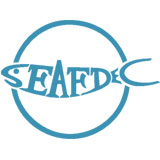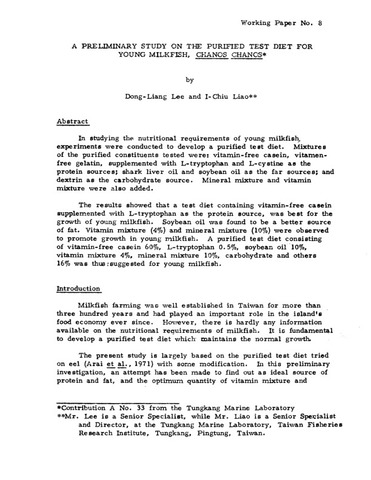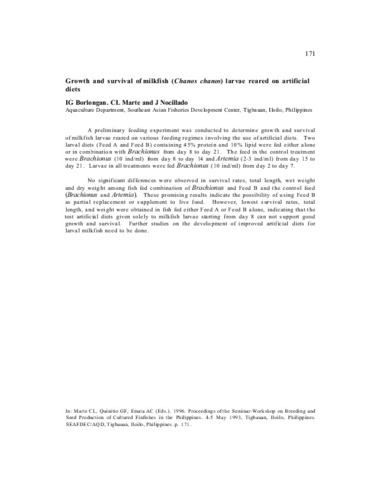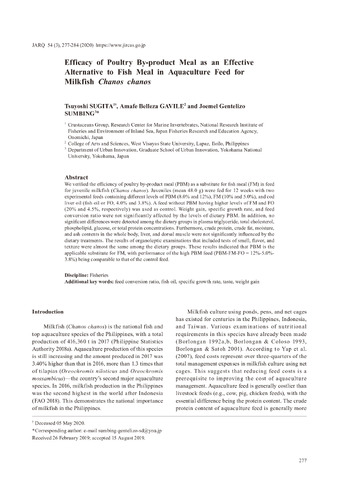Modular method of rearing milkfish with artificial feed.
Share
Abstract
The study was conducted to determine the effectiveness of a practical diet, the profitability of feeding during 2 seasons, and the effect of a diet with coconut oil on the fatty acid profile of milkfish (Chanos chanos ) fingerlings. Milkfish fingerlings of average weight 6.2 g and 10.2 g were reared in earthen ponds of 3 compartments (550, 1,100 and 2,200 m super(2)) using the modular culture system. One month prior to harvest, fish in Treatment 1 were fed a practical diet containing 42% crude protein, 13.1% crude fat and 33.2% nitrogen-free extract while fish in Treatment 2 depended solely on the natural food in the pond. The fish fed during the last month of culture were heavier (141 g) than the unfed fish (100 g) in Experiment 1 (dry season) but had similar weights (44 and 41 g) in Experiment 2 (rainy season). Weight gain of fish in Experiment 1 was significantly higher than in Experiment 2. Varying temperature and salinity during different seasons influenced fish growth and production. Feeding milkfish was not profitable during the cooler months. Fatty acid profile in depot fat of fed fish reflected that of the diet. Palatability tests showed that fed fish were preferred to the unfed fish.
Subject
Taxonomic term
Collections
Related items
Showing items related by title, author, creator and subject.
-
A preliminary study on the purified test diet for young milkfish, Chanos chanos
Lee, Dong-Liang; Liao, I-Chiu (Aquaculture Department, Southeast Asian Fisheries Development Center, 1976)In studying the nutritional requirements of young milkfish experiments were conducted to develop a purified test diet. Mixtures of the purified constituents tested were: vitamin-free casein, vitamin-free gelatin, supplemented ... -
Growth and survival of milkfish (Chanos chanos) larvae reared on artificial diets
Borlongan, I. G.; Marte, C. L.; Nocillado, J. (Aquaculture Department, Southeast Asian Fisheries Development Center, 1996)A preliminary feeding experiment was conducted to determine growth and survival of milkfish larvae reared on various feeding regimes involving the use of artificial diets. Two larval diets (Feed A and Feed B) containing ... -
Efficacy of poultry by-product meal as an effective alternative to fish meal in aquaculture feed for milkfish Chanos chanos
Sugita, Tsuyoshi; Gavile, Amafe B.; Sumbing, Joemel (Japan International Research Center for Agricultural Sciences, 2020)We verified the efficiency of poultry by-product meal (PBM) as a substitute for fish meal (FM) in feed for juvenile milkfish (Chanos chanos). Juveniles (mean 48.0 g) were fed for 12 weeks with two experimental feeds ...






